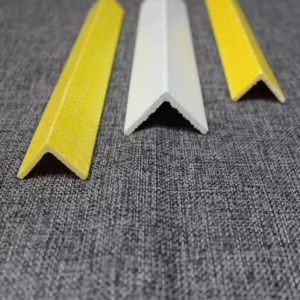Introduction
Advanced manufacturers across power, water, and marine sectors are replacing metal supports with fiberglass angle bar because it solves problems that steel and aluminum can’t: corrosion, conductivity, and weight. A fiberglass angle is a right‑angled pultruded profile made of glass‑fiber rovings bound in thermoset resin, yielding high tensile strength with only a quarter of steel’s density. Unicomposite—an ISO‑certified pultrusion specialist with a dedicated factory in China—has supplied FRP profiles for more than 20 years, giving project teams a deep bench of design and fabrication expertise to draw on.

fiberglass angle bar
Understanding Fiberglass Angle Bar: Composition & Key Properties
What Makes Fiberglass Angle Bar Unique?
Corrosion immunity: No rust in acids, alkalis, or salt spray (ASTM B117 > 5,000 h).
Dielectric safety: 100 kV/in breakdown voltage keeps workers safe around energized conductors.
Light weight: 1.9 g/cm³ density simplifies rooftop or suspended installations.
Pultrusion consistency: Continuous process holds ±0.5 mm dimensional tolerance along unlimited length.
Comparing Fiberglass vs. Steel vs. Aluminum Angles
| Property | Fiberglass | Galvanized Steel | 6061‑T6 Aluminum |
|---|---|---|---|
| Density (g/cm³) | 1.9 | 7.8 | 2.7 |
| Conductivity | Non‑conductive | Highly conductive | Conductive |
| Corrosion Resistance | Excellent | Fair (needs coating) | Good |
| Thermal Expansion (µm/m‑°C) | 9 | 12 | 24 |
The table shows why engineers targeting long service life in aggressive environments increasingly specify FRP angles.
Application #1: Electrical & Utility Infrastructure
Non‑conductive Support Frames & Ladders
Power utilities need ladder rails, cable trays, and transformer stanchions that won’t energize under fault current. Fiberglass angle bar’s dielectric strength meets OSHA 1910 subpart S clearances without extra insulating barriers.
Case Study: Utility Substation Upgrade (North America)
During a 2023 retrofit in Arizona, a transmission company swapped 1,200 ft of corroded steel angles for FRP. Crew‑hour logs show a 42 % installation time reduction because one worker could carry each 20‑ft length. The utility projects savings of US $180,000 in repainting and lost‑time labor over the asset’s 30‑year design life.
Application #2: Water & Wastewater Treatment Facilities
Corrosion‑Resistant Walkways & Structural Supports
Chlorine gas and H₂S attack even epoxy‑coated steel. Fiberglass angle bar maintains 95 % tensile strength after 10 years of ASTM D543 chemical immersion equivalents.
Expert Quote: Plant Engineer on Maintenance Savings
“Switching to FRP angles cut our annual corrosion‑repair budget by half and eliminated safety shutdowns,” says an operations engineer at a Midwest municipal plant processing 75 MGD.
Application #3: Cooling Towers & HVAC Systems
Long‑Span Structural Members in High‑Moisture Environments
Cooling tower drift packs saturate supports 24/7. FRP’s low thermal conductivity (0.35 W/m·K) also reduces heat bridging, boosting overall tower efficiency.
Data Snapshot: Service‑Life Extension Statistics
A 2022 industry survey of 48 hybrid cooling towers reported average service‑life extension of 18 years when switching from redwood and steel to fiberglass structural angles.
Application #4: Marine & Aquaculture Structures
FRP Angle Frames for Offshore Platforms & Cages
Saltwater, UV, and wave fatigue are brutal on metal. Fiberglass angle bar tested to ASTM D638 retained 85 % tensile strength after 12 months of continuous salt‑fog and UV‑B exposure.
Best Practices for UV & Saltwater Exposure
Specify vinyl‑ester resin for maximum chemical resistance.
Add surfacing veil with UV inhibitors.
Design bolted joints with 316 SS hardware isolated by nylon washers to avoid galvanic mixing.
Application #5: Agricultural & OEM Fabrications
Lightweight Frames for Greenhouses & Equipment
Greenhouse roofs and mobile sprayers benefit from lighter framing that reduces fuel use and allows wider spans without center posts.
Design Tips: Integrating Custom Pultruded Profiles
Combine fiberglass angle bar with box beam and wide‑flange pultrusions to create monocoque panels.
Request pre‑drilled or miter‑cut angles from the pultruder to cut field labor by 30 %.
For moving machinery, select E‑glass rovings with impact‑resistant isophthalic resin systems.
Selecting the Right Fiberglass Angle Bar Supplier
Evaluating Quality Standards & Certifications (ISO, ASTM)
A credible supplier should document ISO 9001, provide lot‑traceable mechanical tests, and certify resin content per ASTM D2584. Ask for third‑party fire rating per ASTM E84 if installing indoors.
How Unicomposite Adds Value Through Engineering Support
Unicomposite offers FEA load checks, joint design assistance, and custom color matching—all under one roof. In‑house pultrusion, SMC/BMC molding, and hand lay‑up lines let specifiers consolidate multiple FRP shapes into a single shipment, reducing project complexity.
Conclusion
Fiberglass angle bar minimizes corrosion, weight, and electrical hazards across five demanding sectors while delivering decades of maintenance‑free service. Project teams ready to upgrade can contact Unicomposite’s engineering desk for section properties, sample kits, or a fast quote that aligns with regional standards.
Frequently Asked Questions
Q1. How strong is fiberglass angle bar compared with steel?
Tests show pultruded E‑glass angles achieve tensile strength around 220 MPa—roughly 65 % of mild steel but at one‑quarter the weight, so strength‑to‑weight efficiency is higher.
Q2. Can FRP angles be customized to my dimensions?
Yes. Pultrusion tooling is cost‑effective for medium‑to‑large runs; widths, leg lengths, and wall thicknesses can be tailored, and holes or notches can be machined post‑cure.
Q3. What is the typical lead time for bulk orders?
A standard 40‑ft container of stock sizes ships in 3–4 weeks. Custom colors or resins add 1–2 weeks for die fabrication and curing trials.
Q4. Are fiberglass angles fire‑retardant?
They can be. Specify brominated or phosphorus‑modified resins to meet ASTM E84 Class 1 flame‑spread ≤25 and ensure halogen content complies with local code.
Q5. How are FRP angles joined on site?
Common methods include stainless‑steel bolts with fiberglass gussets or adhesive bonding using two‑part methacrylate; both maintain dielectric isolation.




























